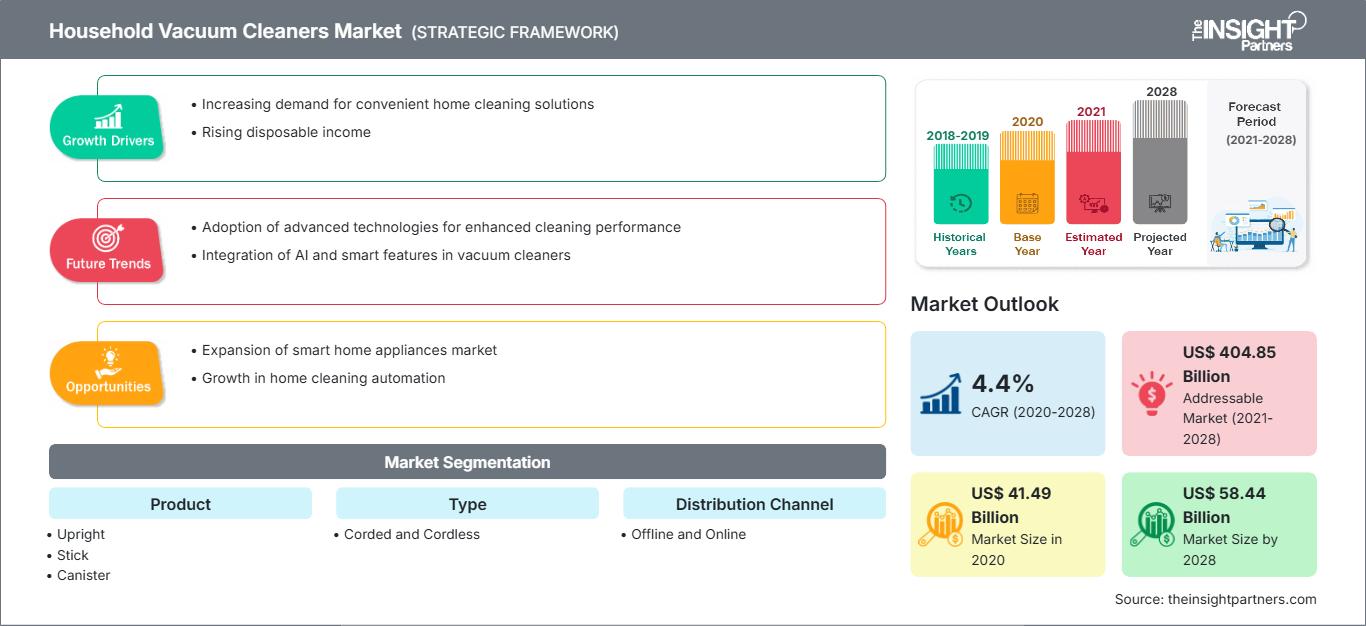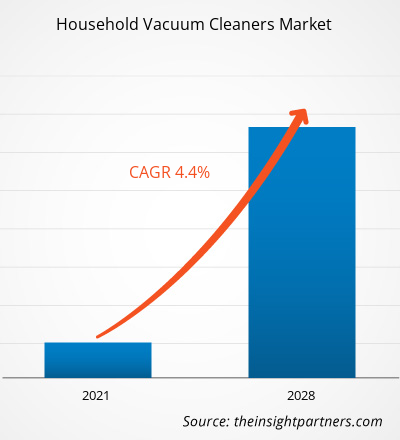2020 年家用吸尘器市场价值为 414.909 亿美元,预计到 2028 年将达到 584.396 亿美元;预计 2021 年至 2028 年的复合年增长率为 4.4%。
家用吸尘器是一种家用电器,利用吸力清洁和清除地板、室内装潢、窗帘和其他表面的碎屑。家用吸尘器有各种尺寸和形状,型号也多种多样,包括立式、罐式、手持式、机器人式等。为了提供便捷、易用和高效的清洁体验,家用吸尘器现已推出无线款,方便携带,可轻松清洁房屋的不同区域。
预测期内,亚太地区是家用吸尘器市场的主要地区,也是增长最快的地区。该地区是 Eureka Forbes、海尔、戴森和荷兰皇家飞利浦公司等主要家用吸尘器制造商的中心,这将为亚太地区的家用吸尘器市场提供各种增长机会。繁忙的工作日程和长时间的工作增加了对智能家电的需求,智能家电将减少家庭在做家务时的体力劳动。与此同时,消费者偏好从传统清洁方式转向现代化清洁方式,这推动了亚太地区家用吸尘器市场的增长。该地区可支配收入的增加以及快速的城市化进程正在推动亚太地区家用吸尘器市场的发展。随着消费者对现代化清洁方式的青睐,家庭卫生意识的增强,以及为节省时间而将日常活动自动化的趋势日益兴起,这些都为亚太地区家用吸尘器市场提供了丰厚的机遇。 - 亚太地区
新冠疫情的爆发彻底改变了家用吸尘器市场的现状。疫情导致国内外边界突然关闭,导致运营效率下降,价值链中断,从而造成收入损失和损害。价值链的中断限制了原材料的供应,进而阻碍了市场增长并影响了终端消费行业的发展。然而,随着各经济体计划恢复运营,预计未来几个月全球对家用吸尘器的需求将会上升。新冠疫情的爆发凸显了民众清洁卫生习惯的重要性。根据欧洲疾病预防控制中心的微学习课程,有证据表明SARSCoV-2病毒颗粒可以通过空气置换并沉积到其他表面。因此,清洁地板至关重要。为此,Oreck提供手持式和罐式吸尘器,它们轻巧便携,并配备强大而卓越的吸力,可轻松清理房间内的杂物。部分Oreck罐式吸尘器配备HEPA过滤系统,可捕获并吸附灰尘、污垢和其他过敏原,防止杂物再次进入家中。吸尘并不能彻底消灭SARS-CoV-2,但它可以使病毒颗粒难以进入空气,从而防止它们被吸入或传播到频繁接触的表面。然而,吸尘仍然可以通过捕获和保留碎屑、灰尘和其他颗粒来显著减少病毒的数量。预计所有这些因素将在未来几年推动全球家用吸尘器的需求增长。
自定义此报告以满足您的要求
您将免费获得任何报告的定制,包括本报告的部分内容,或国家级分析、Excel 数据包,以及为初创企业和大学提供超值优惠和折扣
家用吸尘器市场: 战略洞察

- 获取本报告的主要市场趋势。这个免费样本将包括数据分析,从市场趋势到估计和预测。
市场洞察:吸尘器日益成为清洁卫生的首选
您将免费获得任何报告的定制,包括本报告的部分内容,或国家级分析、Excel 数据包,以及为初创企业和大学提供超值优惠和折扣
家用吸尘器市场: 战略洞察

- 获取本报告的主要市场趋势。这个免费样本将包括数据分析,从市场趋势到估计和预测。
手动清洁房屋一直是居家保持卫生清洁的传统方法。然而,与传统清洁方式相比,家用吸尘器可以更高效、更省时地清洁房屋。如今,家庭对吸尘器的需求已不仅限于清洁,人们还希望这些设备能够保持环境无菌。吸尘器不仅能提供更好、更有效的地板清洁方式,还能净化空气。各大公司正在加大研发投入,推出采用先进电机技术的新型家用吸尘器,以进一步提高机器的能效和性能。例如,2019 年 9 月,Miele 宣布推出其内置高效微粒吸收 (HEPA) 过滤器的新型无绳家用吸尘器。HEPA 过滤器可有效阻止空气中污染物的释放,从而显著改善室内空气质量,降低过敏和哮喘的发生几率。因此,人们越来越喜欢使用家用吸尘器来保持卫生,这推动了市场的增长。
类型洞察
根据类型,家用吸尘器市场分为有线和无线。2020 年,有线吸尘器占据了家用吸尘器市场的主导地位。有线吸尘器插入主电源后吸力强劲。直立式、立式、干湿两用和罐式吸尘器是有线型号的主要产品。有线吸尘器是清洁较大空间的理想选择。有线吸尘器的集尘容量高于无线吸尘器。有线吸尘器在一定程度上便于携带,因为便携式有线吸尘器的电源线长度较长,例如 Eureka Forbes 多功能清洁吸尘器的电源线长度约为 16 英尺。消费者在使用这类吸尘器时面临的主要问题之一就是电线缠绕。
家用吸尘器市场的主要参与者包括:BISSELL、伊莱克斯、荷兰皇家飞利浦、史丹利百得、海尔集团、戴森有限公司、Eureka Forbes、SEB集团、Miele和Oreck Corporation。这些市场主要参与者正专注于并购和产品发布等策略,以扩大地域覆盖范围和消费者群体。
报告重点
- 家用吸尘器行业的发展趋势,帮助参与者制定有效的长期战略
- 公司为确保在发达和发展中市场的增长而采取的业务增长战略
- 2019 年至 2028 年全球家用吸尘器市场的定量分析
- 估计各行业对家用吸尘器的需求
- PEST 分析,说明行业买家和供应商预测市场增长的有效性
- 了解竞争激烈的市场形势和家用吸尘器的需求的最新发展
- 市场趋势和前景,以及推动和抑制家用吸尘器市场增长的因素
- 了解支撑全球家用吸尘器市场增长商业利益的策略,有助于决策过程
- 家用吸尘器市场在不同节点的规模市场
- 全球家用吸尘器市场的详细概述和细分以及其行业动态
- 各地区家用吸尘器市场规模及增长机会
家用吸尘器市场区域洞察
The Insight Partners 的分析师已详尽阐述了预测期内影响家用吸尘器市场的区域趋势和因素。本节还探讨了北美、欧洲、亚太地区、中东和非洲以及南美和中美洲的家用吸尘器市场细分和地域分布。
家用吸尘器市场报告范围
| 报告属性 | 细节 |
|---|---|
| 市场规模 2020 | US$ 41.49 Billion |
| 市场规模 2028 | US$ 58.44 Billion |
| 全球复合年增长率 (2020 - 2028) | 4.4% |
| 历史数据 | 2018-2019 |
| 预测期 | 2021-2028 |
| 涵盖的领域 |
By 产品
|
| 覆盖地区和国家 | 北美
|
| 市场领导者和主要公司简介 |
|
家用吸尘器市场参与者密度:了解其对业务动态的影响
家用吸尘器市场正在快速增长,这得益于终端用户需求的不断增长,而这些需求的驱动因素包括消费者偏好的演变、技术进步以及对产品优势的认知度不断提高。随着需求的增长,企业正在扩展产品线,不断创新以满足消费者需求,并抓住新兴趋势,从而进一步推动市场增长。

- 获取 家用吸尘器市场 主要参与者概述
- 直立式
- 罐式
- 手持式
- 机器人式
- 直立式
- 其他
家用吸尘器市场,按类型
- 有线
- 无线
家用吸尘器市场,按分销渠道
- 线下
- 线上
公司简介
- BISSELL
- Electrolux
- Koninklijke Philips NV
- Stanley Black & Decker, Inc.
- 海尔集团
- 戴森有限公司
- 尤里卡福布斯
- SEB集团
- Miele
- Oreck Corporation
- 历史分析(2 年)、基准年、预测(7 年)及复合年增长率
- PEST和SWOT分析
- 市场规模、价值/数量 - 全球、区域、国家
- 行业和竞争格局
- Excel 数据集
近期报告
客户评价
购买理由
- 明智的决策
- 了解市场动态
- 竞争分析
- 客户洞察
- 市场预测
- 风险规避
- 战略规划
- 投资论证
- 识别新兴市场
- 优化营销策略
- 提升运营效率
- 顺应监管趋势




















 获取免费样品 - 家用吸尘器市场
获取免费样品 - 家用吸尘器市场